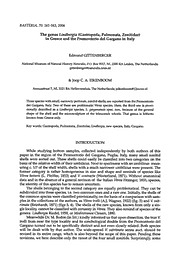
The genus Lindbergia (Gastropoda, Pulmonata, Zonitidae) in Greece and the Promontorio del Gargano in Italy PDF
Preview The genus Lindbergia (Gastropoda, Pulmonata, Zonitidae) in Greece and the Promontorio del Gargano in Italy
BASTERIA,70:161-163,2006 ThegenusLindbergia (Gastropoda, Pulmonata, Zonitidae) inGreeceandthePromontoriodelGargano in Italy EdmundGittenberger National MuseumofNaturalHistory Naturalis,P.O.Box 9517,NL2300RALeiden,The Netherlands; [email protected] & Joop+C.A. Eikenboom Asmusstraat7,NL3221BAHellevoetsluis,TheNetherlands;[email protected] Three specieswith small,narrowlyperforate, zonitidshells,arereportedfrom thePromontorio del Gargano,Italy. Twoofthese are problematicVitrea species. Here,the third oneisprovi- sionally described asa Lindbergiaspecies, L. garganoensisspec. nov., because ofthe general shapeofthe shell and the microsculpture ofthe teleoconch whorls. That genus is hitherto known fromGreeceonly. Keywords:Gastropoda,Pulmonata,Zonitidae,Lindbergia,newspecies, Italy,Gargano. INTRODUCTION Whilestudying bottom samples, collected independently by both authors of this paperin the region of the Promontorio delGargano, Puglia, Italy, many small zonitid shellswere sortedout.These shellscouldeasily be classified into twocategories on the basisoftherelativewidthoftheirumbilicus.Nextto specimens withanumbilicusmeas- uringc. 1/7ofthe shellwidth, shellswithamuchnarrowerumbilicuswerepresent. The former category is ratherhomogeneous in size and shape and reminds of species like Vitrea botterii(L. Pfeiffer, 1853) and V. contracta (Westerlund, 1871). Withoutanatomical dataandin theabsenceofageneral revisionof theItalianVitreaFitzinger, 1833,species, theidentity ofthisspecies hastoremain uncertain. Theshellsbelonging to the secondcategory are equally problematical. They canbe subdividedinto threespecies, i.e.two commononesandarare one.Initially, theshellsof thecommonspecies wereclassifiedprovisionally, onthebasis ofacomparison withsam- plesin thecollectionsof theauthors, as Vitrea trolli(A.J. Wagner, 1922)(fig.5)andV.sub- rimata (Reinhardt, 1871)(figs 3,4). Theshellsof therare species, known fromonly a sin- glelocality, cannot beclassifiedwithcertaintyin Vitrea.They alsoremindof species ofthe genera Lindbergia Riedel, 1959,orMediterraneaClessin, 1880. VMeanwhileDr. M.Bodon(in litt.)kindly informedusthatupo.ndissection,thetrue trollifromnear thetype locality and itsconchological doublefromthePromontoriodel Gargano turnedout tobe specifically distinctand not evenclosely related. Bothspecies willbe dealtwithby that author. Thewide-spread V. subrimata sensu auct. should be revised in itsentirerange, which is alsobeyond the scopeof this paper.Pending these revisions,we heredescribeonly therarest ofthefour smallzonitids. Surprisingly, some 162 BASTERIA, Vol.70, No. 4-6,2006 Figs 1-8.Lindbergiaand Vitrea spec. 1,2,L. garganoensisspec. nov.,paratype,typelocality;3,4, V. cf.sub- rimata, Italy, Foggia, Promontorio delGargano, 2 km W. ofPugnochiuso; 5, V. cf. trolli, do., Foresta Umbra. J.C.A.E.del.& colln.;6,7,Lindbergiagarganoensisspec. nov., typelocality; 6,holotype(National MuseumofNatural History/106683),actual width2.4 mm;7, paratype(J.C.A.Eikenboom colln/01314), actualwidth2.5mm;8, detailofthe holotype.PhotographsbyJ.Goud (Leiden) Gittenberger & Eikenboom:ThegenusLindbergia inGreeceandItaly 163 shells ofthis species were collectedby thepresent authors independently atexactly the samelocality. Incontrast tothevegetated oreven densely forested placeswherethethree more common species were found, these shells were found in a scarcely vegetated, exposed, veryrocky limestonearea withrock facesand boulders.In crevices in asimilar habitat in Greece,Mediterranea ionicus (Riedel & Subai, 1978) or, particularly in Crete, species ofthe genusLindbergia canbefound. TAXONOMY Lindbergia garganoensis spec. nov. (figs 1,2,6-8) Material. — Italy, Foggia, Promontorio del Gargano, 5km NW. ofManfredonia,300-350 m alt. (NationalMuseum ofNatural History 106683/holotype,106678/1 paratype; colln J.C.A. Eikenboom, Hellevoetsluis 01314/7paratypes). Description. — Shellsstrongly depressed, colourless and glossy (fresh specimens), with irregular growth lines; with 3%-4 slightly convex whorls, separated by ashallow suture,whichis somewhatleveledalong thelastwhorl,whileapproaching theaperture. The initialteleoconchwhorls withnumerous, very fine, spiral striae, whichbecomeless clearly visibletowards the lastwhorl. Shell not very fragile; near the aperture the last whorl is slightly thickened inside.Seen from above,the last whorl is 2.3 timesbroader thantheadjoining,visiblepartofthepenultimateone.Theumbilicusisopenbutverynar- row, measuringclearly lessthan0.1oftheshellwidth.Thevery shortcolumellarapertural border is thickened and conspicuously angled in such a way that its insertion on the penultimatewhorlis shiftedaway fromtheshellaxis. Shellheight 1.0-1.3mm, width 2.0-2.6mm. Differentiation.—On theweak basis ofthegeneral shape oftheshelland especially themicrosculpture of theteleoconch whorls, this species is classifiedwithLindbergia. It differsfromthespecies thatareknownin that genusbyitsverynarrowumbilicus and the smallsize. Inthehithertoknown Lindbergia species, theshellsare larger, measuring 3.3- 5.5 mm in width (Riedel, 1980:40). In theMediterraneaspecies the columellarapertural borderis gradually curved andnot conspicuously thickened;with3.5-8.5mm in width, theMediterraneashellsarealso larger. InVitreathe columellarregion maybe similar, but herethelast whorlis usually relatively narrower and thereis noprominent microsculp- ture ofspiral striaeontheinitialteleoconchwhorls.Dataontheanatomyareindispensa- bleforamoresatisfying genericassignment. Distribution. —Lindbergia garganoensis is only known fromthe type locality. Ifits doubtfulclassification is correct,it is the first species ofLindbergia to be reported from Italy. Its occurrence in both the Promontorio del Gargano and the western Balkans remindsof afewmolluscanspecies thathaveasimilardistributionalpattern,likeAcicula disjuncta Boeters, Gittenberger & Subai, 1989,and especially A. szigethyannae Subai,1977 (see Boetersetal., 1989). REFERENCE BOETERS, H.D., E. GITTENBERGER & P. SUBAI, 1989. Die Aciculidae (Mollusca: Gastropoda Prosobranchia). — ZoologischeVerhandelingen252:1-234.
